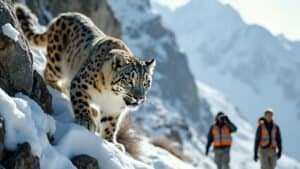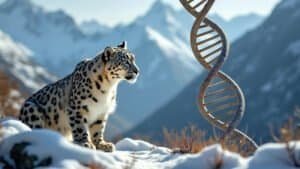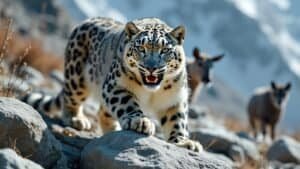Introduction
Estimating snow leopard populations is critical for their conservation and protection
This article explores the various modern methods used to monitor these elusive big cats, including the role of camera traps, the use of DNA analysis, advancements in satellite imagery, and the effectiveness of digital mapping and tracking technologies
Each method offers unique advantages and faces specific challenges, all of which contribute to a comprehensive understanding of snow leopard numbers in the wild
The Role of Camera Traps in Estimating Snow Leopard Populations
How Camera Traps Work
Camera traps are a widely used method in wildlife research, especially for elusive species like the snow leopard. These devices are strategically placed in the wild, often along trails, ridges, and passes where snow leopards are likely to travel
Equipped with motion sensors, camera traps automatically capture images or videos when an animal passes by, allowing researchers to collect data without human presence, which minimizes disturbance to the wildlife
Camera traps use infrared technology to detect movement and heat, ensuring they function effectively day and night. The data collected includes not only the number of individual leopards but also their behavior, habitat use, and interactions with other species. This method provides a non-invasive means to gather extensive data over long periods
Advantages of Camera Traps
One of the primary advantages of camera traps is their ability to operate continuously in harsh and remote environments, such as the high-altitude habitats of snow leopards
They provide a wealth of photographic evidence that can be analyzed to identify individual leopards through unique patterns of their rosettes and spots. This identification process is crucial for estimating population sizes and understanding dynamics within the population
Additionally, camera traps can cover large areas and collect data over extended periods, which is essential for studying a species that ranges widely and has low population densities. The use of multiple camera traps allows for a more comprehensive survey of an area, increasing the likelihood of capturing images of snow leopards and other wildlife
Case Studies of Camera Trap Usage
Several successful case studies highlight the effectiveness of camera traps in snow leopard research. For instance, the Snow Leopard Trust has deployed camera traps across various regions of Central Asia, yielding valuable data on snow leopard populations
In one study conducted in the Tost Mountains of Mongolia, camera traps helped researchers estimate a population density of 0.38 snow leopards per 100 square kilometers, providing a baseline for conservation efforts
In India, camera traps have been instrumental in the long-term monitoring of snow leopards in the Spiti Valley, Himachal Pradesh. The data collected has informed the development of conservation strategies and policies at both national and local levels
These studies demonstrate that camera traps are a powerful tool in wildlife research, offering insights that are critical for the effective conservation of snow leopards
Using DNA Analysis for Tracking Snow Leopard Numbers
Types of DNA Sampling Techniques
DNA analysis has revolutionized wildlife population studies, providing precise and reliable data on genetic diversity and population structure. For snow leopards, non-invasive sampling methods are typically used to collect DNA
These methods include the collection of scat (feces), hair, and urine from the wild. Scat sampling is the most common technique because it is relatively easy to find and collect without disturbing the animals
Once collected, these samples are sent to laboratories where DNA is extracted and analyzed
Techniques such as Polymerase Chain Reaction (PCR) are used to amplify the DNA, making it possible to identify individual animals and assess genetic diversity within the population. Advanced methods like next-generation sequencing (NGS) further enhance the accuracy and depth of genetic analysis
Benefits of Genetic Analysis
Genetic analysis provides several advantages in monitoring snow leopard populations. Firstly, it allows for the identification of individual leopards, which is essential for estimating population sizes and tracking changes over time
By analyzing genetic markers, researchers can determine relatedness among individuals, assess genetic health, and detect signs of inbreeding or genetic bottlenecks
Furthermore, DNA analysis helps in understanding the connectivity between different snow leopard populations. This information is crucial for conservation planning, as it identifies key habitats and corridors that need protection to maintain genetic flow between populations
Genetic data also contribute to forensic investigations, helping to combat wildlife trafficking and poaching by identifying the origins of confiscated animal parts
Real-World Applications and Success Stories
Several successful projects demonstrate the effectiveness of DNA analysis in snow leopard conservation. In Nepal, the National Trust for Nature Conservation (NTNC) conducted a study using scat samples collected from the Annapurna Conservation Area
The genetic analysis revealed the presence of at least 18 individual snow leopards, providing a baseline for future monitoring efforts and guiding conservation strategies in the region
In Pakistan’s Gilgit-Baltistan region, researchers used DNA from scat samples to estimate a snow leopard population density of 0.25 individuals per 100 square kilometers. This study highlighted the importance of maintaining habitat connectivity between protected areas to support genetic diversity and long-term survival of the species
The Global Snow Leopard & Ecosystem Protection Program (GSLEP) has also incorporated genetic monitoring into its conservation framework. By coordinating efforts across multiple countries, GSLEP aims to create a comprehensive genetic database of snow leopards, enhancing our understanding of their population dynamics and informing international conservation policies
Advancements in Satellite Imagery for Snow Leopard Monitoring
Technology Behind Satellite Imagery
Satellite imagery has emerged as a powerful tool in wildlife conservation, offering a bird’s-eye view of vast and remote landscapes that are often difficult to access. For snow leopards, which inhabit rugged mountainous regions, satellite technology provides critical data on habitat use, movement patterns, and environmental changes
Modern satellites equipped with high-resolution sensors can capture detailed images of the Earth’s surface, even in challenging weather conditions
Satellite imagery allows researchers to map and monitor snow leopard habitats with precision. Techniques such as remote sensing and Geographic Information Systems (GIS) enable the analysis of land cover, vegetation, and terrain features
These technologies help identify potential snow leopard habitats and assess the impact of human activities such as mining, infrastructure development, and climate change on these areas
Examples of Satellite Usage
One notable example of using satellite imagery in snow leopard conservation is the Global Land Analysis and Discovery (GLAD) system, which provides near-real-time monitoring of forest cover and land-use changes
By integrating GLAD data with on-the-ground observations, researchers can quickly identify habitat loss and degradation, allowing for timely intervention and conservation action
In Kyrgyzstan, the use of satellite imagery has been instrumental in mapping critical snow leopard habitats within protected areas like the Sarychat-Ertash State Reserve. Satellite data combined with camera trap information has helped create detailed habitat suitability models, guiding conservation efforts and management plans to ensure the protection of key areas
Another example is the integration of satellite imagery with collar tracking data from snow leopards fitted with GPS collars
This combination allows researchers to visualize movement patterns and habitat use on a large scale. By analyzing satellite images alongside GPS data, scientists can gain insights into how snow leopards navigate their environment, select habitats, and respond to seasonal changes
Limitations and Challenges
While satellite imagery offers many benefits, it also has limitations and challenges. One significant challenge is the resolution of satellite images
Although high-resolution satellites can capture detailed images, distinguishing snow leopards from their surroundings can be difficult due to their camouflaged fur and the complex terrain they inhabit. This necessitates the use of complementary methods, such as camera traps and DNA analysis, to accurately identify and monitor individuals
Another challenge is the cost associated with accessing high-resolution satellite data. While some satellite data are freely available, higher-resolution images required for detailed habitat analysis can be expensive. This financial barrier can limit the use of satellite technology in some conservation projects, particularly in regions with limited funding
Additionally, the interpretation of satellite data requires specialized skills and software, which may not be readily available to all conservation organizations. Training and capacity-building efforts are essential to equip researchers and conservationists with the tools and knowledge needed to effectively use satellite imagery in their work
Effectiveness of Digital Mapping and Tracking Technologies
Overview of Digital Mapping Tools
Digital mapping tools have revolutionized wildlife conservation by providing detailed and interactive representations of animal habitats and movement patterns
For snow leopards, Geographic Information Systems (GIS) are widely used to create maps that illustrate the distribution of these elusive cats. GIS integrates various data sources, such as camera trap locations, GPS collar data, and satellite imagery, to produce comprehensive maps that are crucial for conservation planning
Other digital mapping tools include habitat suitability models, which predict the likelihood of snow leopard presence based on environmental variables such as altitude, slope, and vegetation cover. These models help identify critical habitats that need protection and inform management strategies to ensure the survival of snow leopard populations
Tracking Technologies in Use
GPS collars are among the most effective tracking technologies used to monitor snow leopards. These collars are fitted to individual leopards and provide real-time data on their movements and behaviors. The data collected from GPS collars is invaluable for understanding home range sizes, movement corridors, and habitat preferences
Radio telemetry is another tracking technology used in snow leopard research. Unlike GPS collars, which rely on satellite signals, radio collars emit a frequency that researchers track using handheld receivers. This method is often used in conjunction with GPS collars to enhance tracking accuracy and reliability
Another innovative tracking technology is the use of drones. Drones equipped with cameras and thermal imaging sensors can survey large and remote areas, capturing images and videos that help locate snow leopards and assess their habitats. Drones offer a non-invasive way to monitor snow leopard populations, particularly in regions where traditional methods are challenging to implement
Comparative Analysis of Methods
Each tracking technology has its strengths and limitations, making them suitable for different aspects of snow leopard research. GPS collars provide precise location data, but they require capturing and handling the animals, which can be stressful and logistically complex
However, the detailed movement data they offer is unmatched, making them a preferred choice for in-depth studies on snow leopard behavior and ecology
Radio telemetry is less invasive than GPS collars and can be used in areas with poor satellite coverage. However, it requires researchers to be in relatively close proximity to the animals, which can be challenging in the rugged terrain snow leopards inhabit. Despite this limitation, radio telemetry is a valuable tool for short-term studies and supplementary tracking
Drones offer a non-intrusive alternative, capable of covering vast areas and providing high-resolution imagery. However, their effectiveness can be limited by weather conditions and the ruggedness of the terrain
Additionally, drones require skilled operators and can be costly to deploy regularly. Nevertheless, their ability to quickly survey large areas makes them a promising tool for snow leopard conservation
Combining these technologies often yields the best results. For instance, using GPS collars to gather detailed movement data, drones to monitor habitats, and radio telemetry for additional tracking can provide a comprehensive understanding of snow leopard populations and their conservation needs. By leveraging the strengths of each method, researchers can develop more effective and holistic conservation strategies
Challenges in Estimating Snow Leopard Populations
Geographic and Environmental Obstacles
Estimating snow leopard populations presents significant geographic and environmental challenges. Snow leopards inhabit some of the most remote and rugged terrains on Earth, including high-altitude mountain ranges like the Himalayas, the Tian Shan, and the Altai
These regions are characterized by extreme weather conditions, difficult access, and vast, expansive areas, making it challenging for researchers to conduct field studies
The harsh climate, with freezing temperatures, heavy snowfall, and low oxygen levels at high altitudes, further complicates data collection efforts
Researchers must be well-equipped and physically prepared to endure these conditions, which often limits the duration and frequency of fieldwork. Additionally, the rugged terrain makes it difficult to deploy and maintain equipment such as camera traps and tracking devices
Technical and Logistical Issues
The technical aspects of population estimation also pose significant hurdles. Camera traps, while effective, require regular maintenance, including battery changes and data retrieval
Inaccessible locations often mean that setting up and maintaining these traps is logistically complex and resource-intensive. Similarly, capturing and fitting GPS collars to snow leopards requires specialized skills, equipment, and often a team of experts, adding to the logistical challenges
DNA analysis, while highly accurate, depends on the successful collection of samples such as scat or hair. In vast and rugged habitats, locating these samples can be time-consuming and challenging. Furthermore, ensuring that samples are uncontaminated and suitable for genetic analysis requires careful handling and preservation, which can be difficult in remote field conditions
Strategies to Overcome Challenges
Despite these challenges, several strategies have been developed to improve the accuracy and efficiency of snow leopard population estimates. One approach is the use of community-based monitoring programs. By training and involving local communities in data collection efforts, researchers can significantly expand their field presence
Local people, who are familiar with the terrain and wildlife, can assist in setting up camera traps, collecting DNA samples, and reporting sightings, thus enhancing the scope and depth of research
Technological advancements also play a crucial role in overcoming obstacles. For example, the development of more durable and long-lasting camera traps reduces the need for frequent maintenance. Innovations in GPS collar design, such as more lightweight and comfortable collars, improve the success rates of tracking studies
Additionally, the use of satellite communications to transmit data from remote locations minimizes the need for physical retrieval of information
Collaborative efforts and international cooperation are essential for addressing the challenges of snow leopard research. By sharing data, resources, and expertise, conservation organizations can create more comprehensive and coordinated strategies
Programs like the Global Snow Leopard & Ecosystem Protection Program (GSLEP) facilitate such collaborations, fostering a unified approach to snow leopard conservation across their range
Another strategy is the integration of multiple methods to triangulate data and improve accuracy. For instance, combining camera trap data with genetic analysis and satellite imagery provides a more holistic view of snow leopard populations and their habitats. This multi-faceted approach helps to cross-verify findings and fill gaps that might be left by any single method
Conclusion
Accurately estimating snow leopard populations is crucial for effective conservation efforts. This article has explored various modern methods used to monitor these elusive big cats, including the use of camera traps, DNA analysis, satellite imagery, and digital mapping and tracking technologies
Each method offers unique advantages and faces specific challenges, contributing to a comprehensive understanding of snow leopard numbers in the wild
Camera traps provide continuous, non-invasive data collection in harsh environments, while DNA analysis offers precise individual identification and insights into genetic health
Advancements in satellite imagery allow for extensive habitat mapping, and digital tracking technologies, such as GPS collars and drones, enable detailed movement and behavior studies. Despite the geographic, technical, and logistical challenges, innovative strategies and collaborative efforts enhance the accuracy and efficiency of population estimates
Through these diverse methodologies, researchers and conservationists can better protect and manage snow leopard populations, ensuring their survival for future generations







